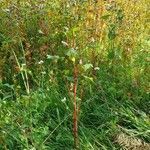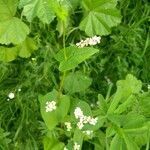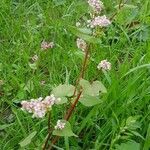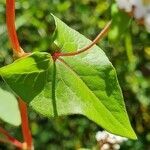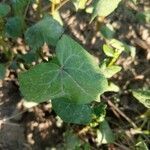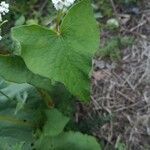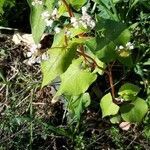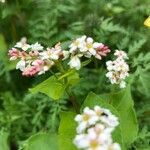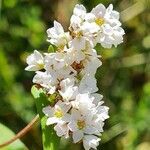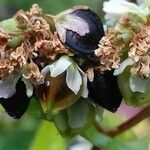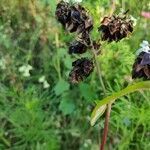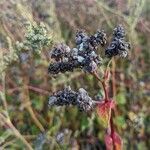Herbs annual. Stems green or red when mature, erect, 30-90 cm tall, branched above, glabrous or papillate on one side. Petiole 1.5-5 cm; leaf blade triangular, 2.5-7 × 2-5 cm, both surfaces papillate along veins, base cordate or nearly truncate, apex acuminate; ocrea caducous, ca. 5 mm, membranous, oblique, not ciliate. Inflorescence axillary or terminal, racemose or corymbose; peduncles 2-4 cm, papillate along one side; bracts green, ovate, 2.5-3 mm, margin membranous, each 3-or 5-flowered. Pedicels longer than bracts, not articulate. Perianth pink or white; tepals elliptic, 3-4 mm. Anthers pinkish. Styles heterostylous. Achenes exceeding persistent perianth, dark brown, opaque, ovoid, sharply trigonous, 5-6 mm, surfaces flat. Fl. May-Sep, fr. Jun-Oct. 2n = 16*, 32*.
Twining or erect, perennial or annual herb, with hollow stems up to 0.6 m high. Leaves triangular-sagittate, cordate; ocrea short, truncate, entire. Inflorescence branched or flowers in axillary clusters. Flowers unisexual, heterostylous; male flowers in narrow, terminal and axillary, raceme-like panicles; pedicels articulated above middle, equalling perianth in length. Perianth campanulate, with 5 segments, not accrescent. Stamens 8, alternating with yellow nectaries on disc. Ovary 3-angled; styles 3, long and slender; stigmas capitate, small. Flowering time summer. Fruit a triquetrous nut, greatly exceeding perianth.
Branched annual herb to c. 70 cm high, puberulent below and on nodes. Ochreae c. 5 mm long, entire. Petiole < to > blade. Lamina to c. 7 × 6 cm, broad-or ovate-triangular, glabrous or nearly so, often somewhat sinuate; base truncate to shallowly cordate; apex acute. Panicles on slender peduncles subtended by sessile lvs. Fls densely arranged. Bracts herbaceous, short-acuminate. Perianth 1.2-4.5 mm long, white or pinkish. Anthers mostly pink. Perianth of ♂ fls 1.2-2.5 mm long. Nuts 6-8 × 4-5.5 mm, acutely 3-angled, smooth, blackish with pale whitish dashes or brown with dark marks.
An upright annual herb up to 1 m high. It spreads to 1 m across. It has angular hollow stems. These are erect and branching. Leaves are heart shaped or triangular and small. It has groups of white or pink flowers. These have a smell. They occur in clusters at the ends of branches. Fruit are small and 3 angled. The plants are not grasses but the seeds are normally grouped with other grain crops.
Annual, 2–6 dm, the stem pubescent in lines above; lvs broadly triangular-hastate, the lower long-petioled; fl-clusters usually crowded and compact to form a terminal, corymbiform infl; tep elliptic, obtuse, 2–3 mm, achene smooth and shining, 5–7 mm, with smooth, entire angles, much exceeding the tep. 2n=16. Commonly escaped from cult., but not long persistent. June–Sept. (F. sagittatum)
Annual herb, up to 0.6 m high. Stems erect. Leaves with blade triangular-sagittate, 40-100 x 20-100 mm, base cordate, apex acute. Ocrea 3-5 mm long, striate. Flowers: in bracteate, terminal or axillary, raceme-like panicles; perianth greenish white, tipped pink; Dec.-May. Fruit accrescent, nut at least twice as long as perianth, pale brown, matt, sharply trigonous.
Annual herb, up to 0.6 m high. Leaves triangular-sagittate, cordate at base. Nut accrescent, pale brown, matt, sharply trigonous. Flowers white or cream.
